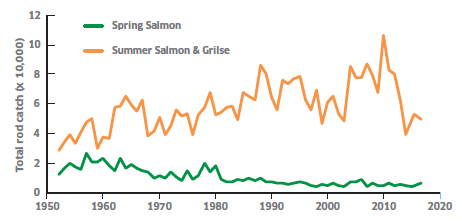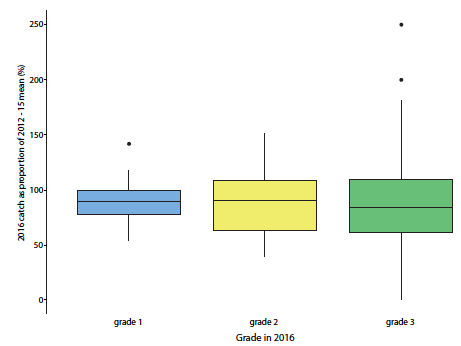Salmon fishery statistics: 2016 season
Salmon catch statistics for the 2016 season.
Catch and Effort Reported by Scottish Salmon Fisheries in 2016
The rod and line fishery
A total of 5,597 wild salmon and grilse was reported caught and retained in the rod and line fishery. A further 49,512 wild salmon and grilse were reported caught and released. The combined retained and released rod catch is 55,109, which is 80% of the previous 5-year average. We have no time series of fishing effort information associated with the rod and line fishery.
Annual rod catch generally increased over the period 1952 to 2010. The reported catch dropped in each subsequent year until in 2014 it was the second lowest on record. Reported rod catch recovered slightly in 2015 and 2016 (Figure 1).
Figure 1: Rod And Line Fishery.

Trends in total rod catch vary among individual stock components (Figure 2). Spring salmon catch (for the purposes of this report defined as multi sea-winter fish taken before 1 May) has generally declined since records began. Although stabilising in recent years, catches remain at a historically low level. Overall catch of salmon and grilse in later months generally increased up to 2010, after which it fell sharply only to recover slightly in 2015 and 2016.
Figure 2: Trends In Stock Components, Rod And Line Fishery.

Catch and release
The proportion of the rod catch accounted for by catch and release has generally increased since 1994, when such information was first recorded.
In 2016, 90% of the annual rod catch was released compared to less than 8% in 1994. Similarly, less than 1% of rod caught spring salmon were released in 1994 while 98% were released in 2016 (Figure 3). A proportion of fish released from the rod fishery may be re-caught and hence inflate the catch statistics by appearing in the reported data more than once.
The net fisheries
Reported catch and effort for the fixed engine and net & coble fisheries in 2016 were the lowest recorded by either fishery since records began in 1952.
Figure 3: Catch And Release, Rod And Line Fishery.

As a result of the Salmon Conservation Regulations (see below), retention of salmon caught in coastal waters was prohibited.
A total of 35 wild salmon and grilse was reported caught and retained in a scientific haaf net fishery from a reported fishing effort of 209 net months. Haaf net fisheries in the Solway reported a further 128 net months with no salmon and grilse retained.
Effort returns from Solway fisheries do not yield data that can be easily combined with returns from gear types in the rest of Scotland and data from this region are generally omitted when calculating a national index for fixed engine fishing effort. In 2016, fixed engine effort for Scotland excluding Solway was reported as 13 trap months with no salmon and grilse retained.
A total of 2,811 wild salmon and grilse was reported caught and retained in the net & coble fishery from a reported effort of 41 crew months.
The catch by fishing method
In 2016, approximately 95% of the total annual reported catch was accounted for by the rod fisheries. Net & coble fisheries comprised 5% with fixed engine fisheries accounting for less than 0.1%. Restricting the analysis to the retained catch, the rods accounted for approximately 66% of the catch compared to less than 1% and 33% for the fixed engine and net & coble fisheries respectively.
Rod fisheries accounted for 100% of both the overall and retained reported catches of spring salmon in 2016.
Farmed salmon and grilse
A total of 34 fish of farmed origin was reported caught by all methods in 2016. Fish of farmed origin represented 0.1% of the total number of salmon and grilse caught.
Figure 4: Boxplot Showing The 2016 Total Catch Expressed As A Proportion Of The 2011-2015 Mean Catch For Assessment Areas Grouped By Grade In 2016. The Horizontal Line Within The Box Indicates The Median Value Of Each Distribution And The Box And Whiskers Describe Each Distribution.

Impact of the Salmon Conservation Regulations.
Salmon Conservation Regulations for Scottish stocks came into force in 2016 and included measures to prohibit the killing of fish in coastal waters and in estuaries and rivers where the stocks were determined to be in poor conservation status. Of the 126 assessable areas, 88 were assessed as being in poor conservation status (grade 3) in 2016.
Fishery statistics reported for 2016 provide a first view of the impact of these management measures on the catches of salmon. These may be summarised as
- Total retained catch of salmon and grilse (all methods) fell from 22,776 in 2015 to 8,443 in 2016
- Total retained catch (all methods) of spring salmon fell from 213 in 2015 to 101 in 2016
- Catch and release in the rod and line fishery rose from 84% in 2015 to 90% in 2016
Before the regulations came into force, concern was expressed that rod fisheries in areas with compulsory catch and release would be adversely impacted by these measures. To examine this contention, 2016 rod catch was expressed as a proportion of the average catch from 2011 to 2015 for the 126 assessable areas. Figure 4 shows the distribution of these data for each of the categories and highlights that there were no significant differences between the different grades.
Thus, although individual fisheries may have been impacted by the regulations, there is no evidence to support a contention that fisheries in grade 3 areas suffered a disproportionate drop in catch compared to fisheries in areas with moderate or good conservation status where killing of salmon was permitted (grades 1 and 2).
Downloads
Topic sheet no. 67 explains how we collect the catch statistics.
Topic sheet no. 69 summarises the sea trout fishery statistics for the 2016 fishing season.
Both topic sheets are available for download at http://www.gov.scot/Topics/marine/Publications/TopicSheets/tslist
Summary data for fishing seasons 1952 to 2016 are available for download at http://www.gov.scot/Topics/marine/science/Publications/stats/SalmonSeaTroutCatches
These data are provided as the most complete at the time of publication. Our records are amended when further information becomes available and updated annually in April when the statistics for the most recent fishing season are published.
Contact
If you have a specific request for Scottish salmon and sea trout fishery information, not available at the links on this page, please contact us directly at ms.catchform@gov.scot
Contact
Email: Marine Scotland Science
Phone: 0300 244 4000 – Central Enquiry Unit
The Scottish Government
St Andrew's House
Regent Road
Edinburgh
EH1 3DG
There is a problem
Thanks for your feedback